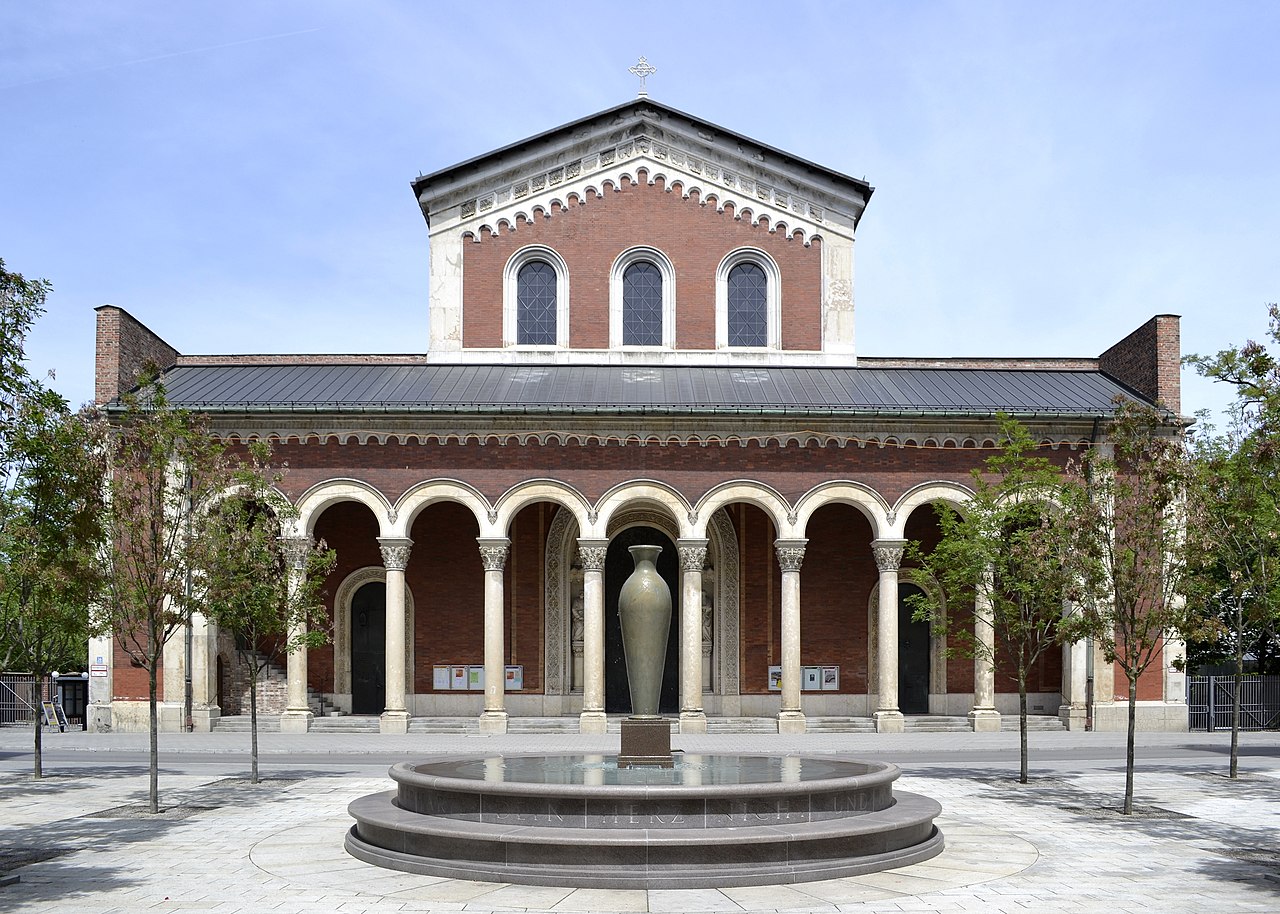by Susan Flantzer
© Unofficial Royalty 2025

Saint Boniface Abbey Church; Credit- Eigenes Werk, CC BY 3.0 de, https://commons.wikimedia.org/w/index.php?curid=15352400
Saint Boniface Abbey is a Benedictine abbey in Munich, in the German state of Bavaria, formerly the Kingdom of Bavaria. It was founded in 1835 by King Ludwig I of Bavaria who wanted to revive Roman Catholic spiritual life by founding new monasteries. Many monasteries were destroyed or used for other purposes from 1802 to 1814 during a period of secularization, called the German Mediatization.
Saint Boniface (born Wynfreth circa 675, martyred June 5, 754) was an English Benedictine monk who was a missionary to parts of today’s Germany during the eighth century. German Roman Catholics regard him as an important national figure. The foundation stone was laid on October 12, 1835, the 25th wedding anniversary of King Ludwig I and Queen Therese of Bavaria, born Princess Therese of Saxe-Hildburghausen. On a side note, Ludwig and Therese’s wedding on October 12, 1810, was held in a large outdoor space in Munich called the Theresienwiese. Named for his bride, Theresienwiese is the site of Oktoberfest, held every year to commemorate the wedding.

Tomb of King Ludwig I of Bavaria; Credit – Von Berthold Werner, CC BY-SA 3.0, https://commons.wikimedia.org/w/index.php?curid=62142909
In March 1848, King Ludwig I abdicated because he refused to reign as a constitutional monarch, and lost the support of his family and government ministers. Queen Therese died on October 26, 1854, and was initially buried in the royal crypt at the Theatinerkirche in Munich. Three years later, her husband had her remains moved to St. Boniface’s Abbey where he was also buried after his death on February 29, 1868.

Burial Site of Queen Therese of Bavaria; Credit – Wikipedia
St. Boniface Abbey is located in a city, unusual for a Benedictine monastery, Monasteries were usually located near farmlands to support the monastery’s monks. King Ludwig II bought the former Andechs Abbey in Andechs, in the German state of Bavaria, secularised in 1803, along with its supporting farmlands, and gave it St. Boniface Abbey to support the monks of the monastery. In 1850, the former Andechs Abbey was refounded as a Benedictine priory affiliated with St. Boniface Abbey. Andechs Abbey served as a burial place for the House of Wittelsbach, the ruling family in Bavaria, since the Middle Ages.
Besides Andechs Abbey, members of the House of Wittelsbach are interred at the Theatinerkirche in Munich, the Frauenkirche (Church of Our Lady) in Munich, and the Michaelskirche (St. Michael’s Church) in Munich. In 1977, Albrecht, Duke of Bavaria, Head of the House of Wittelsbach and pretender to the former Bavarian throne from 1955 until he died in 1996, set up a Wittelsbach private family cemetery in the Andechs Abbey garden due to the lack of space in the other Wittelsbach burial sites. The private family cemetery complex is now the main burial place of the Wittelsbach family.

An 1862 drawing of St. Boniface Abbey Church; Credit – Wikipedia
The architecture of the Saint Boniface Abbey Church, designed by the architect Georg Friedrich Ziebland (link in German), was based on early Christian basilicas. King Ludwig I sent Ziebland on a two-year study trip (1827 – 1829) to Italy to study Roman basilicas. For the Saint Boniface Abbey Church, Ziebland was inspired by Early Christian architecture and Byzantine architecture, using the round arch style and a terracotta and brick combination.

Saint Boniface Abbey Church interior before it was damaged during World War II; Credit – Wikipedia

St Boniface Abbey Church reconstructed by Hans Döllgast, 1948–1950, photographed before 1971; Credit – Hans Döllgast, post-war reconstruction and modern architecture
During World War II, on April 25, 1944 and January 7, 1945, Saint Boniface Abbey Church was badly damaged. German architect, graphic artist, and university professor Hans Döllgast (link in German), who worked on many post-war reconstruction projects, reconstructed the interior of the abbey church between 1948 and 1950. The nave was shortened to about a third of its original length. Nothing remained of the mosaics and frescoes in the style of Roman basilicas.
In 1988, a competition was announced that would enable the redecoration of the church’s interior. German painter Peter Burkart created a frieze of colored paintings above the arcades (a series of joined arches used to create a covered walkway or area).

The current interior of St. Boniface Abbey Church. Painter Peter Burkart’s frieze of colored paintings, mentioned above. can be seen. Credit – Von Digital cat – Eigenes Werk, CC BY-SA 4.0, https://commons.wikimedia.org/w/index.php?curid=43876001
Friedrich Koller created the relief over the interior portal with the end of time speech from the Gospel of Matthew verse 24, where Jesus describes signs and events that will precede his return. In the left aisle is a Stations of the Cross with colored prints created by Bernd Hendl between. Nearby is a sculpture by Christine Stadler of Saint Elisabeth of Hungary.
This article is the intellectual property of Unofficial Royalty and is NOT TO BE COPIED, EDITED, OR POSTED IN ANY FORM ON ANOTHER WEBSITE under any circumstances. It is permissible to use a link that directs to Unofficial Royalty.
Works Cited
- Autoren der Wikimedia-Projekte. (2004). Benediktinerkloster in München. Wikipedia.org; Wikimedia Foundation, Inc. https://de.wikipedia.org/wiki/Abtei_St._Bonifaz_(M%C3%BCnchen)
- Autoren der Wikimedia-Projekte. (2008, June 25). Georg Friedrich Ziebland Deutscher Architekt und Baumeister. Wikipedia.org; Wikimedia Foundation, Inc. https://de.wikipedia.org/wiki/Georg_Friedrich_Ziebland
- Sternberg, Maximilian. (2022). Hans Döllgast, post-war reconstruction and modern architecture. The Journal of Architecture, 1–36. https://doi.org/10.1080/13602365.2022.2086152
- Wikipedia Contributors. (2024). St. Boniface’s Abbey. Wikipedia; Wikimedia Foundation.
